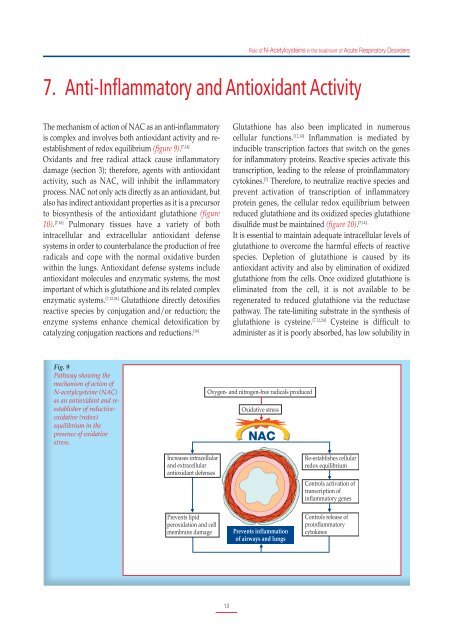Therapeutics
Role of N-Acetylcysteine
Role of N-Acetylcysteine
- No tags were found...
You also want an ePaper? Increase the reach of your titles
YUMPU automatically turns print PDFs into web optimized ePapers that Google loves.
Role of N-Acetylcysteine in the treatment of Acute Respiratory Disorders<br />
7. Anti-Inflammatory and Antioxidant Activity<br />
The mechanism of action of NAC as an anti-inflammatory<br />
is complex and involves both antioxidant activity and reestablishment<br />
of redox equilibrium (figure 9). [7,14]<br />
Oxidants and free radical attack cause inflammatory<br />
damage (section 3); therefore, agents with antioxidant<br />
activity, such as NAC, will inhibit the inflammatory<br />
process. NAC not only acts directly as an antioxidant, but<br />
also has indirect antioxidant properties as it is a precursor<br />
to biosynthesis of the antioxidant glutathione (figure<br />
10). [7,16] Pulmonary tissues have a variety of both<br />
intracellular and extracellular antioxidant defense<br />
systems in order to counterbalance the production of free<br />
radicals and cope with the normal oxidative burden<br />
within the lungs. Antioxidant defense systems include<br />
antioxidant molecules and enzymatic systems, the most<br />
important of which is glutathione and its related complex<br />
enzymatic systems. [7,12,24] Glutathione directly detoxifies<br />
reactive species by conjugation and/or reduction; the<br />
enzyme systems enhance chemical detoxification by<br />
catalyzing conjugation reactions and reductions. [16]<br />
Glutathione has also been implicated in numerous<br />
cellular functions. [12,14] Inflammation is mediated by<br />
inducible transcription factors that switch on the genes<br />
for inflammatory proteins. Reactive species activate this<br />
transcription, leading to the release of proinflammatory<br />
cytokines. [7] Therefore, to neutralize reactive species and<br />
prevent activation of transcription of inflammatory<br />
protein genes, the cellular redox equilibrium between<br />
reduced glutathione and its oxidized species glutathione<br />
disulfide must be maintained (figure 10). [7,14]<br />
It is essential to maintain adequate intracellular levels of<br />
glutathione to overcome the harmful effects of reactive<br />
species. Depletion of glutathione is caused by its<br />
antioxidant activity and also by elimination of oxidized<br />
glutathione from the cells. Once oxidized glutathione is<br />
eliminated from the cell, it is not available to be<br />
regenerated to reduced glutathione via the reductase<br />
pathway. The rate-limiting substrate in the synthesis of<br />
glutathione is cysteine. [7,12,24] Cysteine is difficult to<br />
administer as it is poorly absorbed, has low solubility in<br />
Fig. 9<br />
Pathway showing the<br />
mechanism of action of<br />
N-acetylcysteine (NAC)<br />
as an antioxidant and reestablisher<br />
of reductiveoxidative<br />
(redox)<br />
equilibrium in the<br />
presence of oxidative<br />
stress.<br />
Oxygen- and nitrogen-free radicals produced<br />
Oxidative stress<br />
NAC<br />
Increases intracellular<br />
and extracellular<br />
antioxidant defenses<br />
Re-establishes cellular<br />
redox equilibrium<br />
Controls activation of<br />
transcription of<br />
inflammatory genes<br />
Prevents lipid<br />
peroxidation and cell<br />
membrane damage<br />
Prevents inflammation<br />
of airways and lungs<br />
Controls release of<br />
proinflammatory<br />
cytokines<br />
13


